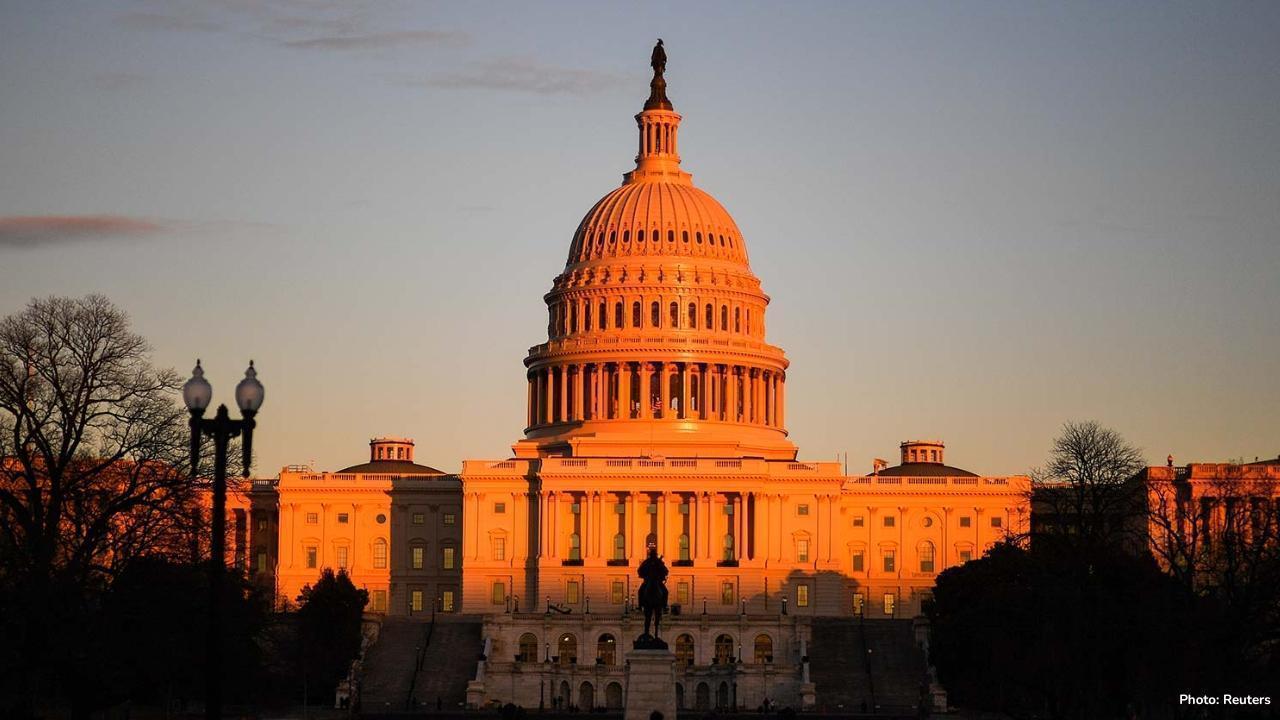
Post by : Monika
On October 1, 2025, the United States government entered a partial shutdown after Congress failed to pass a funding measure needed to keep federal operations running.
This shutdown is the 15th in U.S. history since 1981 and comes as a result of disagreements between Democrats and Republicans over federal spending and health benefits. It has halted a wide range of government operations, disrupted services, and caused financial uncertainty for millions of Americans who rely on government programs.
Background of the Shutdown
The U.S. federal government requires periodic approval from Congress to fund its operations. When a spending bill is not passed before the fiscal year ends, which in this case was September 30, parts of the government must temporarily stop operations. This type of shutdown occurs when there is no agreement on funding allocations for federal agencies and programs.
In this instance, the Senate failed to pass a short-term spending bill that would have funded the government through November 21, 2025. The primary point of contention was a provision to extend health benefits for millions of Americans. Democrats supported including the health benefits, arguing that they are essential for citizens who rely on federal programs. Republicans opposed the inclusion, insisting that health benefits should be handled separately from the general funding bill.
The total funding in question was approximately $1.7 trillion, covering day-to-day agency operations. The remaining government expenditures, such as social security, Medicare, and interest payments on the $37.5 trillion national debt, are automatically funded and continue during a shutdown.
Impact on Federal Operations
The partial shutdown has immediate and visible effects on various federal operations:
1. Federal Employees:
Around 750,000 federal workers have been furloughed, meaning they are temporarily laid off without pay. This number includes many employees who perform administrative, regulatory, and non-essential duties. Essential personnel, such as military members, law enforcement officers, and emergency responders, continue to work but may experience delayed paychecks.
2. Economic Reporting:
Critical economic data releases, such as the September employment report, have been postponed. These reports provide valuable insights into the health of the U.S. economy and guide decisions made by the Federal Reserve and policymakers. Delays in reporting can affect financial markets and business planning.
3. Air Travel and Transportation:
The Federal Aviation Administration (FAA) has furloughed over 11,000 staff, including air traffic controllers and administrative personnel. While essential personnel remain on duty, reduced staffing could lead to slower processing times, delays, and increased safety concerns at airports.
4. Military Operations:
Active-duty military personnel continue to work but are experiencing delayed paychecks. The delay can affect morale and day-to-day personal finances, although the Department of Defense ensures that essential operations continue without interruption.
5. Scientific and Research Programs:
Government-funded research projects in health, energy, space, and technology have been affected. Research funding for projects conducted by the National Institutes of Health (NIH), NASA, and the Department of Energy is paused, which could delay experiments, clinical trials, and space missions.
6. Public Services:
Many public-facing services, such as processing of government applications, visa and passport services, and non-emergency support lines, have been suspended. Citizens seeking these services are facing longer wait times or temporary inability to access them.
Political Context
The shutdown reflects deep divisions between political parties in Congress. President Donald Trump, a Republican, has pushed for a funding bill without additional provisions, emphasizing his goal of reducing government spending and federal workforce size. Democrats, in contrast, have insisted that the bill include health benefit extensions for millions of Americans who rely on government programs.
This disagreement highlights the challenge of reaching bipartisan consensus in Washington. Neither side has been willing to compromise, resulting in a deadlock that has forced the government to partially shut down. The political standoff also demonstrates how policy disagreements can have immediate consequences on ordinary citizens and federal employees.
President Trump has framed the shutdown as a tool to advance his agenda of reducing government size and spending. His administration has already planned to cut around 300,000 federal jobs by the end of the year. The shutdown provides an opportunity to implement some of these reductions without going through additional legislation.
Economic Consequences
The shutdown has caused concern among economists, businesses, and financial markets:
Stock Markets: U.S. stock futures dropped as investors reacted to the uncertainty surrounding government operations. The shutdown increases financial market volatility, affecting investor confidence and investment decisions.
Consumer Confidence: Uncertainty about government services and delayed paychecks for federal workers can reduce consumer spending, which is a significant component of U.S. economic growth. Reduced spending could slow the economy if the shutdown continues.
Cost to the Government: The Office of Management and Budget estimates that the government loses about $400 million per day in productivity and wages during a shutdown. Long-term shutdowns increase costs due to delayed projects and additional administrative work required once operations resume.
Impact on Small Businesses: Businesses that rely on federal contracts or permits are affected. Delays in approvals and payments disrupt cash flow and operational planning for these companies.
Federal Budget and Debt Considerations
The funding dispute involves $1.7 trillion for agency operations, roughly a quarter of the government’s total $7 trillion budget. Other mandatory spending programs, such as Social Security, Medicare, and interest on the national debt, are not affected by the shutdown.
However, the government’s debt obligations continue to grow, and the shutdown raises questions about the sustainability of spending practices. If prolonged, the shutdown could affect credit ratings, borrowing costs, and investor confidence in U.S. financial markets.
Public Reaction
The shutdown has sparked widespread concern among federal employees, citizens, and businesses. Furloughed workers worry about missing paychecks and financial obligations. Citizens relying on government services face delays in accessing essential programs, including social services, healthcare, and regulatory assistance.
Public opinion is often divided during shutdowns. Some view the political stalemate as an unnecessary disruption that harms ordinary people. Others see it as a necessary measure to pressure lawmakers into making long-term policy changes.
Historical Context
This is the 15th government shutdown in the United States since 1981. Previous shutdowns have ranged in length from a few hours to several weeks. Historically, shutdowns occur due to disagreements over budget allocations, policy provisions, or political strategy.
Notably, the longest shutdown in U.S. history lasted 35 days from December 2018 to January 2019. That shutdown affected federal employees, government services, and economic growth, demonstrating the potential consequences of prolonged funding impasses.
Outlook and Resolution
As of October 1, 2025, there is no clear timeline for resolving the shutdown. Negotiations are ongoing, but both parties remain firm in their positions. Experts suggest that a temporary resolution could come in the form of a continuing resolution, which would temporarily fund the government while providing more time for lawmakers to negotiate a long-term budget.
Economists warn that the longer the shutdown continues, the more severe the economic and social impact. Prolonged shutdowns can result in delayed projects, reduced economic output, and lasting damage to public trust in government institutions.
The partial U.S. government shutdown that began on October 1, 2025, is a direct result of political deadlock over federal funding and policy provisions. It has immediate consequences for federal employees, citizens, businesses, and the overall economy. While essential services continue, many non-essential operations have halted, creating disruption and uncertainty.
The outcome of ongoing negotiations between Congress and the President will determine how long the shutdown lasts and how severe its effects will be. Monitoring the situation is crucial for understanding its impact on the U.S. economy, financial markets, and citizens’ daily lives.
U.S. Government Shutdown Federal Employees Economic Impact










Dodgers Win Game 1 of Wild Card Series Against Reds
The Dodgers beat the Reds 10-5 in Game 1 of the Wild Card Series. Ohtani and Hernández hit two home

Tyreek Hill Suffers Major Knee Injury, Out for the Season
Miami Dolphins' star receiver Tyreek Hill tears ACL and other ligaments in win over Jets; season-end

China Raises Flag at Disputed Shoal in National Day Ceremony
On China’s National Day, its coast guard held a flag ceremony at Scarborough Shoal, asserting contro

Netanyahu Bets Big on Trump’s Gaza Plan, Faces Home Risks
Netanyahu supports Trump’s Gaza peace plan to regain global support, but his far-right partners in I

Ukraine’s frontline cities face fear but refuse to give up
In Ukraine’s frontline towns, people live with fear and danger daily, yet they show courage, refusin

US Government Shuts Down After Congress Fails to Agree
On October 1, 2025, the U.S. government began a partial shutdown due to Congress's inability to pass